Analyzing People Management in Organizations: A Tesco Report
VerifiedAdded on 2023/01/18
|10
|3323
|44
Report
AI Summary
This report provides a comprehensive analysis of people management within an organizational context, using Tesco as a case study. It delves into crucial aspects of human resource management, including recruitment, selection, training, and induction processes, highlighting their significance in attracting and retaining skilled employees. The report further examines factors influencing employee behavior and teamwork, such as work culture, leadership styles, and effective communication. It also explores various leadership styles like transformative, transactional, participative, and autocratic approaches. Additionally, the report discusses organizational structure and culture, emphasizing the importance of aligning policies, norms, and employee behavior to achieve organizational objectives. The report concludes by emphasizing the importance of effective people management for organizational success.
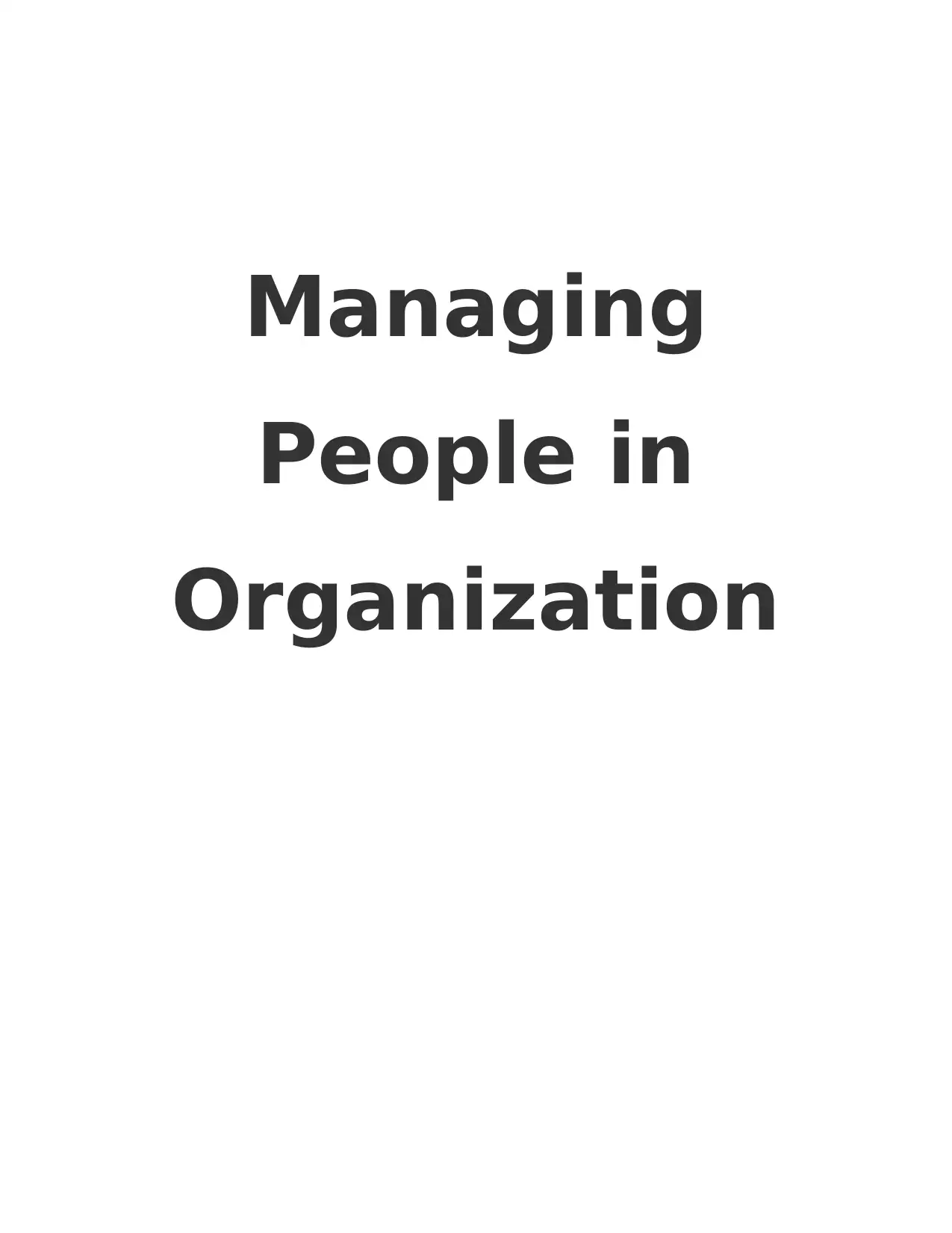
Managing
People in
Organization
People in
Organization
Paraphrase This Document
Need a fresh take? Get an instant paraphrase of this document with our AI Paraphraser
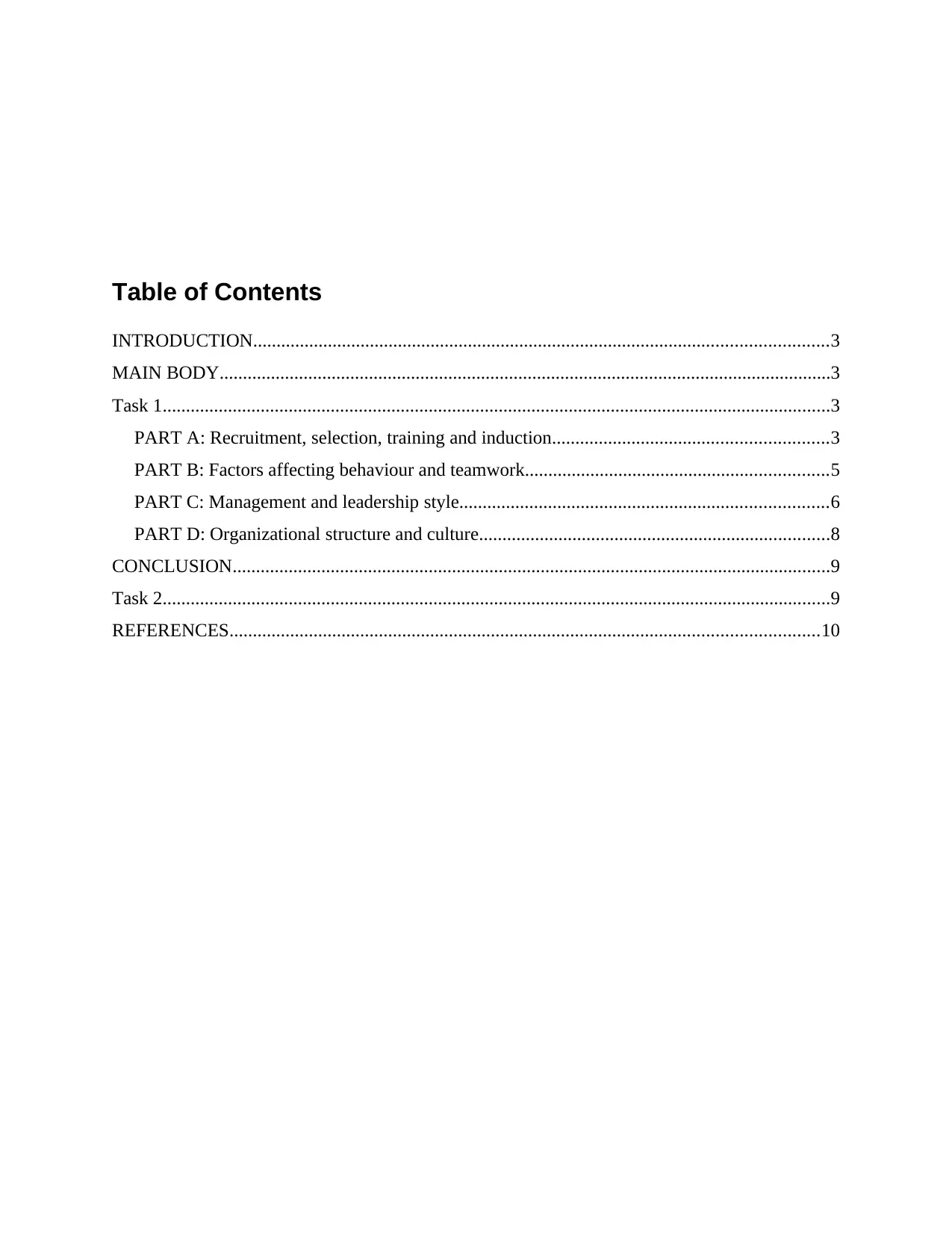
Table of Contents
INTRODUCTION...........................................................................................................................3
MAIN BODY...................................................................................................................................3
Task 1...............................................................................................................................................3
PART A: Recruitment, selection, training and induction...........................................................3
PART B: Factors affecting behaviour and teamwork.................................................................5
PART C: Management and leadership style...............................................................................6
PART D: Organizational structure and culture...........................................................................8
CONCLUSION................................................................................................................................9
Task 2...............................................................................................................................................9
REFERENCES..............................................................................................................................10
INTRODUCTION...........................................................................................................................3
MAIN BODY...................................................................................................................................3
Task 1...............................................................................................................................................3
PART A: Recruitment, selection, training and induction...........................................................3
PART B: Factors affecting behaviour and teamwork.................................................................5
PART C: Management and leadership style...............................................................................6
PART D: Organizational structure and culture...........................................................................8
CONCLUSION................................................................................................................................9
Task 2...............................................................................................................................................9
REFERENCES..............................................................................................................................10
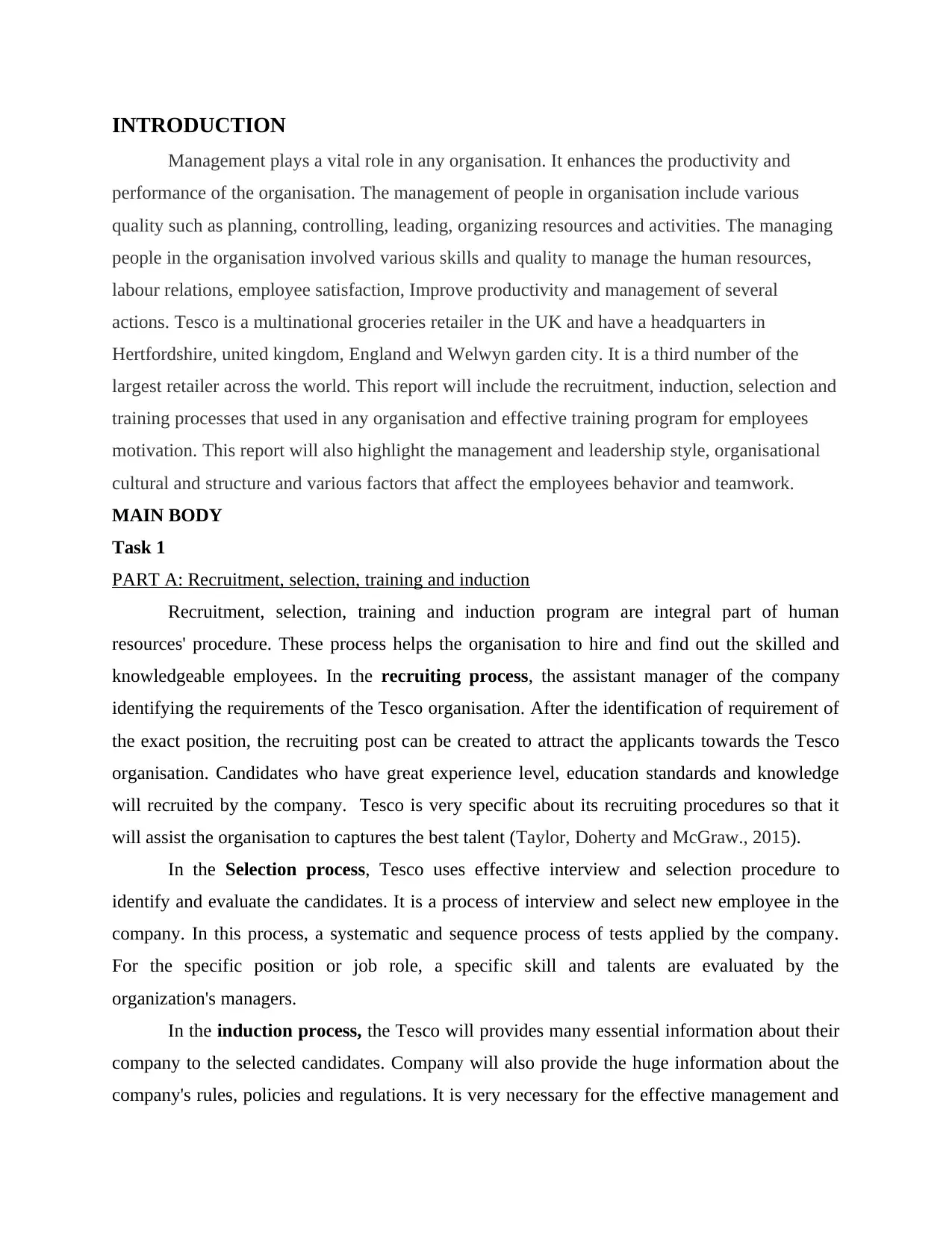
INTRODUCTION
Management plays a vital role in any organisation. It enhances the productivity and
performance of the organisation. The management of people in organisation include various
quality such as planning, controlling, leading, organizing resources and activities. The managing
people in the organisation involved various skills and quality to manage the human resources,
labour relations, employee satisfaction, Improve productivity and management of several
actions. Tesco is a multinational groceries retailer in the UK and have a headquarters in
Hertfordshire, united kingdom, England and Welwyn garden city. It is a third number of the
largest retailer across the world. This report will include the recruitment, induction, selection and
training processes that used in any organisation and effective training program for employees
motivation. This report will also highlight the management and leadership style, organisational
cultural and structure and various factors that affect the employees behavior and teamwork.
MAIN BODY
Task 1
PART A: Recruitment, selection, training and induction
Recruitment, selection, training and induction program are integral part of human
resources' procedure. These process helps the organisation to hire and find out the skilled and
knowledgeable employees. In the recruiting process, the assistant manager of the company
identifying the requirements of the Tesco organisation. After the identification of requirement of
the exact position, the recruiting post can be created to attract the applicants towards the Tesco
organisation. Candidates who have great experience level, education standards and knowledge
will recruited by the company. Tesco is very specific about its recruiting procedures so that it
will assist the organisation to captures the best talent (Taylor, Doherty and McGraw., 2015).
In the Selection process, Tesco uses effective interview and selection procedure to
identify and evaluate the candidates. It is a process of interview and select new employee in the
company. In this process, a systematic and sequence process of tests applied by the company.
For the specific position or job role, a specific skill and talents are evaluated by the
organization's managers.
In the induction process, the Tesco will provides many essential information about their
company to the selected candidates. Company will also provide the huge information about the
company's rules, policies and regulations. It is very necessary for the effective management and
Management plays a vital role in any organisation. It enhances the productivity and
performance of the organisation. The management of people in organisation include various
quality such as planning, controlling, leading, organizing resources and activities. The managing
people in the organisation involved various skills and quality to manage the human resources,
labour relations, employee satisfaction, Improve productivity and management of several
actions. Tesco is a multinational groceries retailer in the UK and have a headquarters in
Hertfordshire, united kingdom, England and Welwyn garden city. It is a third number of the
largest retailer across the world. This report will include the recruitment, induction, selection and
training processes that used in any organisation and effective training program for employees
motivation. This report will also highlight the management and leadership style, organisational
cultural and structure and various factors that affect the employees behavior and teamwork.
MAIN BODY
Task 1
PART A: Recruitment, selection, training and induction
Recruitment, selection, training and induction program are integral part of human
resources' procedure. These process helps the organisation to hire and find out the skilled and
knowledgeable employees. In the recruiting process, the assistant manager of the company
identifying the requirements of the Tesco organisation. After the identification of requirement of
the exact position, the recruiting post can be created to attract the applicants towards the Tesco
organisation. Candidates who have great experience level, education standards and knowledge
will recruited by the company. Tesco is very specific about its recruiting procedures so that it
will assist the organisation to captures the best talent (Taylor, Doherty and McGraw., 2015).
In the Selection process, Tesco uses effective interview and selection procedure to
identify and evaluate the candidates. It is a process of interview and select new employee in the
company. In this process, a systematic and sequence process of tests applied by the company.
For the specific position or job role, a specific skill and talents are evaluated by the
organization's managers.
In the induction process, the Tesco will provides many essential information about their
company to the selected candidates. Company will also provide the huge information about the
company's rules, policies and regulations. It is very necessary for the effective management and
⊘ This is a preview!⊘
Do you want full access?
Subscribe today to unlock all pages.

Trusted by 1+ million students worldwide
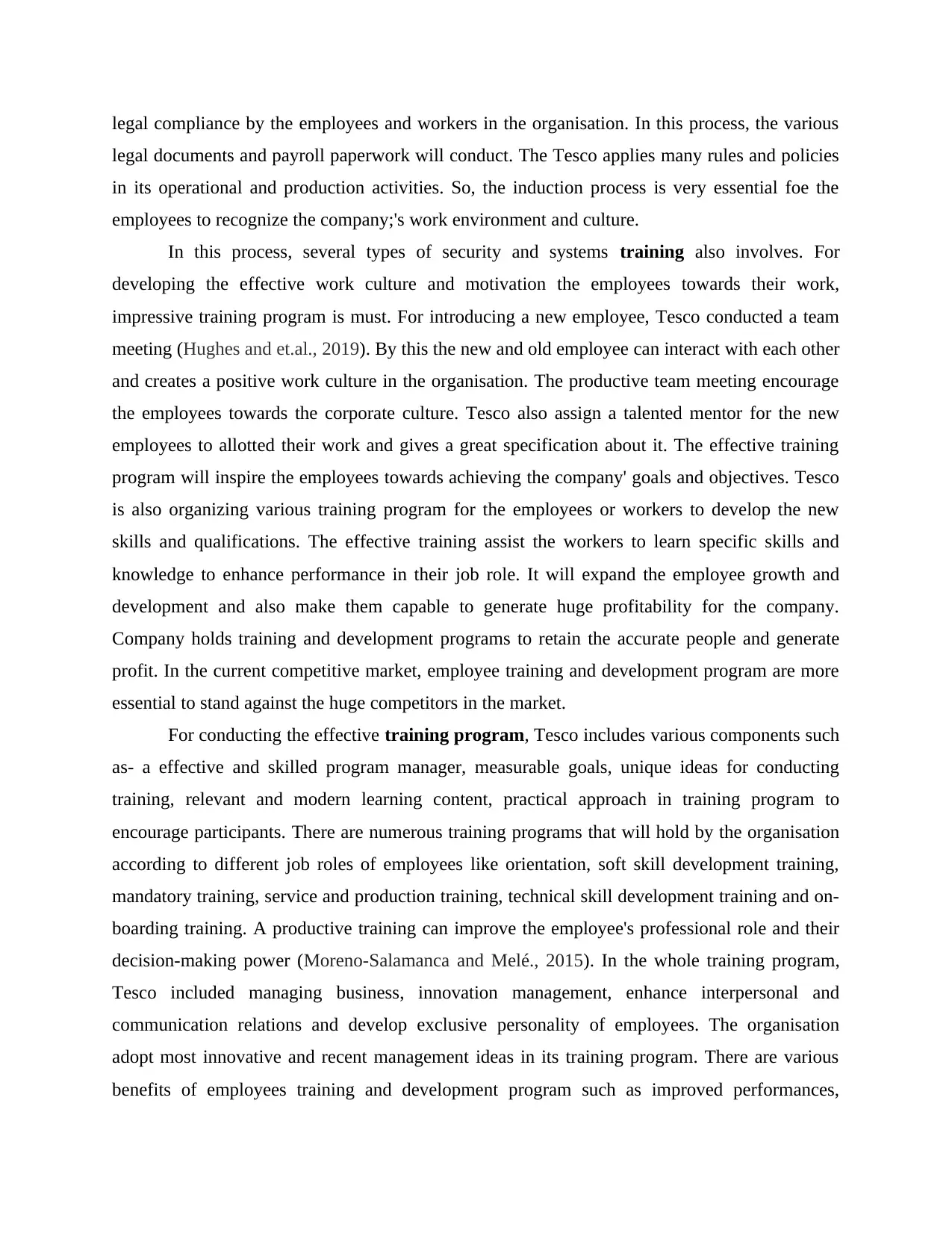
legal compliance by the employees and workers in the organisation. In this process, the various
legal documents and payroll paperwork will conduct. The Tesco applies many rules and policies
in its operational and production activities. So, the induction process is very essential foe the
employees to recognize the company;'s work environment and culture.
In this process, several types of security and systems training also involves. For
developing the effective work culture and motivation the employees towards their work,
impressive training program is must. For introducing a new employee, Tesco conducted a team
meeting (Hughes and et.al., 2019). By this the new and old employee can interact with each other
and creates a positive work culture in the organisation. The productive team meeting encourage
the employees towards the corporate culture. Tesco also assign a talented mentor for the new
employees to allotted their work and gives a great specification about it. The effective training
program will inspire the employees towards achieving the company' goals and objectives. Tesco
is also organizing various training program for the employees or workers to develop the new
skills and qualifications. The effective training assist the workers to learn specific skills and
knowledge to enhance performance in their job role. It will expand the employee growth and
development and also make them capable to generate huge profitability for the company.
Company holds training and development programs to retain the accurate people and generate
profit. In the current competitive market, employee training and development program are more
essential to stand against the huge competitors in the market.
For conducting the effective training program, Tesco includes various components such
as- a effective and skilled program manager, measurable goals, unique ideas for conducting
training, relevant and modern learning content, practical approach in training program to
encourage participants. There are numerous training programs that will hold by the organisation
according to different job roles of employees like orientation, soft skill development training,
mandatory training, service and production training, technical skill development training and on-
boarding training. A productive training can improve the employee's professional role and their
decision-making power (Moreno-Salamanca and Melé., 2015). In the whole training program,
Tesco included managing business, innovation management, enhance interpersonal and
communication relations and develop exclusive personality of employees. The organisation
adopt most innovative and recent management ideas in its training program. There are various
benefits of employees training and development program such as improved performances,
legal documents and payroll paperwork will conduct. The Tesco applies many rules and policies
in its operational and production activities. So, the induction process is very essential foe the
employees to recognize the company;'s work environment and culture.
In this process, several types of security and systems training also involves. For
developing the effective work culture and motivation the employees towards their work,
impressive training program is must. For introducing a new employee, Tesco conducted a team
meeting (Hughes and et.al., 2019). By this the new and old employee can interact with each other
and creates a positive work culture in the organisation. The productive team meeting encourage
the employees towards the corporate culture. Tesco also assign a talented mentor for the new
employees to allotted their work and gives a great specification about it. The effective training
program will inspire the employees towards achieving the company' goals and objectives. Tesco
is also organizing various training program for the employees or workers to develop the new
skills and qualifications. The effective training assist the workers to learn specific skills and
knowledge to enhance performance in their job role. It will expand the employee growth and
development and also make them capable to generate huge profitability for the company.
Company holds training and development programs to retain the accurate people and generate
profit. In the current competitive market, employee training and development program are more
essential to stand against the huge competitors in the market.
For conducting the effective training program, Tesco includes various components such
as- a effective and skilled program manager, measurable goals, unique ideas for conducting
training, relevant and modern learning content, practical approach in training program to
encourage participants. There are numerous training programs that will hold by the organisation
according to different job roles of employees like orientation, soft skill development training,
mandatory training, service and production training, technical skill development training and on-
boarding training. A productive training can improve the employee's professional role and their
decision-making power (Moreno-Salamanca and Melé., 2015). In the whole training program,
Tesco included managing business, innovation management, enhance interpersonal and
communication relations and develop exclusive personality of employees. The organisation
adopt most innovative and recent management ideas in its training program. There are various
benefits of employees training and development program such as improved performances,
Paraphrase This Document
Need a fresh take? Get an instant paraphrase of this document with our AI Paraphraser
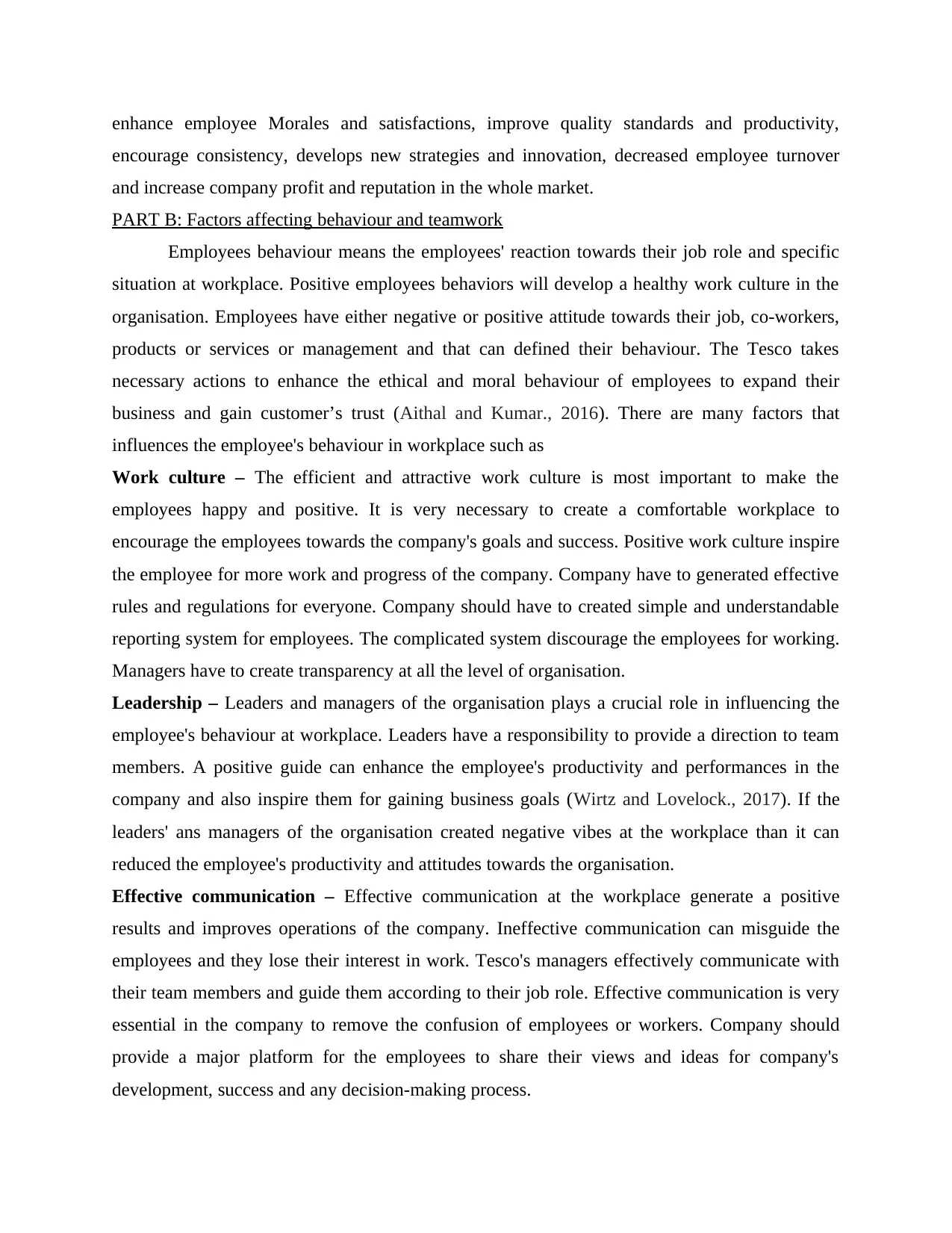
enhance employee Morales and satisfactions, improve quality standards and productivity,
encourage consistency, develops new strategies and innovation, decreased employee turnover
and increase company profit and reputation in the whole market.
PART B: Factors affecting behaviour and teamwork
Employees behaviour means the employees' reaction towards their job role and specific
situation at workplace. Positive employees behaviors will develop a healthy work culture in the
organisation. Employees have either negative or positive attitude towards their job, co-workers,
products or services or management and that can defined their behaviour. The Tesco takes
necessary actions to enhance the ethical and moral behaviour of employees to expand their
business and gain customer’s trust (Aithal and Kumar., 2016). There are many factors that
influences the employee's behaviour in workplace such as
Work culture – The efficient and attractive work culture is most important to make the
employees happy and positive. It is very necessary to create a comfortable workplace to
encourage the employees towards the company's goals and success. Positive work culture inspire
the employee for more work and progress of the company. Company have to generated effective
rules and regulations for everyone. Company should have to created simple and understandable
reporting system for employees. The complicated system discourage the employees for working.
Managers have to create transparency at all the level of organisation.
Leadership – Leaders and managers of the organisation plays a crucial role in influencing the
employee's behaviour at workplace. Leaders have a responsibility to provide a direction to team
members. A positive guide can enhance the employee's productivity and performances in the
company and also inspire them for gaining business goals (Wirtz and Lovelock., 2017). If the
leaders' ans managers of the organisation created negative vibes at the workplace than it can
reduced the employee's productivity and attitudes towards the organisation.
Effective communication – Effective communication at the workplace generate a positive
results and improves operations of the company. Ineffective communication can misguide the
employees and they lose their interest in work. Tesco's managers effectively communicate with
their team members and guide them according to their job role. Effective communication is very
essential in the company to remove the confusion of employees or workers. Company should
provide a major platform for the employees to share their views and ideas for company's
development, success and any decision-making process.
encourage consistency, develops new strategies and innovation, decreased employee turnover
and increase company profit and reputation in the whole market.
PART B: Factors affecting behaviour and teamwork
Employees behaviour means the employees' reaction towards their job role and specific
situation at workplace. Positive employees behaviors will develop a healthy work culture in the
organisation. Employees have either negative or positive attitude towards their job, co-workers,
products or services or management and that can defined their behaviour. The Tesco takes
necessary actions to enhance the ethical and moral behaviour of employees to expand their
business and gain customer’s trust (Aithal and Kumar., 2016). There are many factors that
influences the employee's behaviour in workplace such as
Work culture – The efficient and attractive work culture is most important to make the
employees happy and positive. It is very necessary to create a comfortable workplace to
encourage the employees towards the company's goals and success. Positive work culture inspire
the employee for more work and progress of the company. Company have to generated effective
rules and regulations for everyone. Company should have to created simple and understandable
reporting system for employees. The complicated system discourage the employees for working.
Managers have to create transparency at all the level of organisation.
Leadership – Leaders and managers of the organisation plays a crucial role in influencing the
employee's behaviour at workplace. Leaders have a responsibility to provide a direction to team
members. A positive guide can enhance the employee's productivity and performances in the
company and also inspire them for gaining business goals (Wirtz and Lovelock., 2017). If the
leaders' ans managers of the organisation created negative vibes at the workplace than it can
reduced the employee's productivity and attitudes towards the organisation.
Effective communication – Effective communication at the workplace generate a positive
results and improves operations of the company. Ineffective communication can misguide the
employees and they lose their interest in work. Tesco's managers effectively communicate with
their team members and guide them according to their job role. Effective communication is very
essential in the company to remove the confusion of employees or workers. Company should
provide a major platform for the employees to share their views and ideas for company's
development, success and any decision-making process.
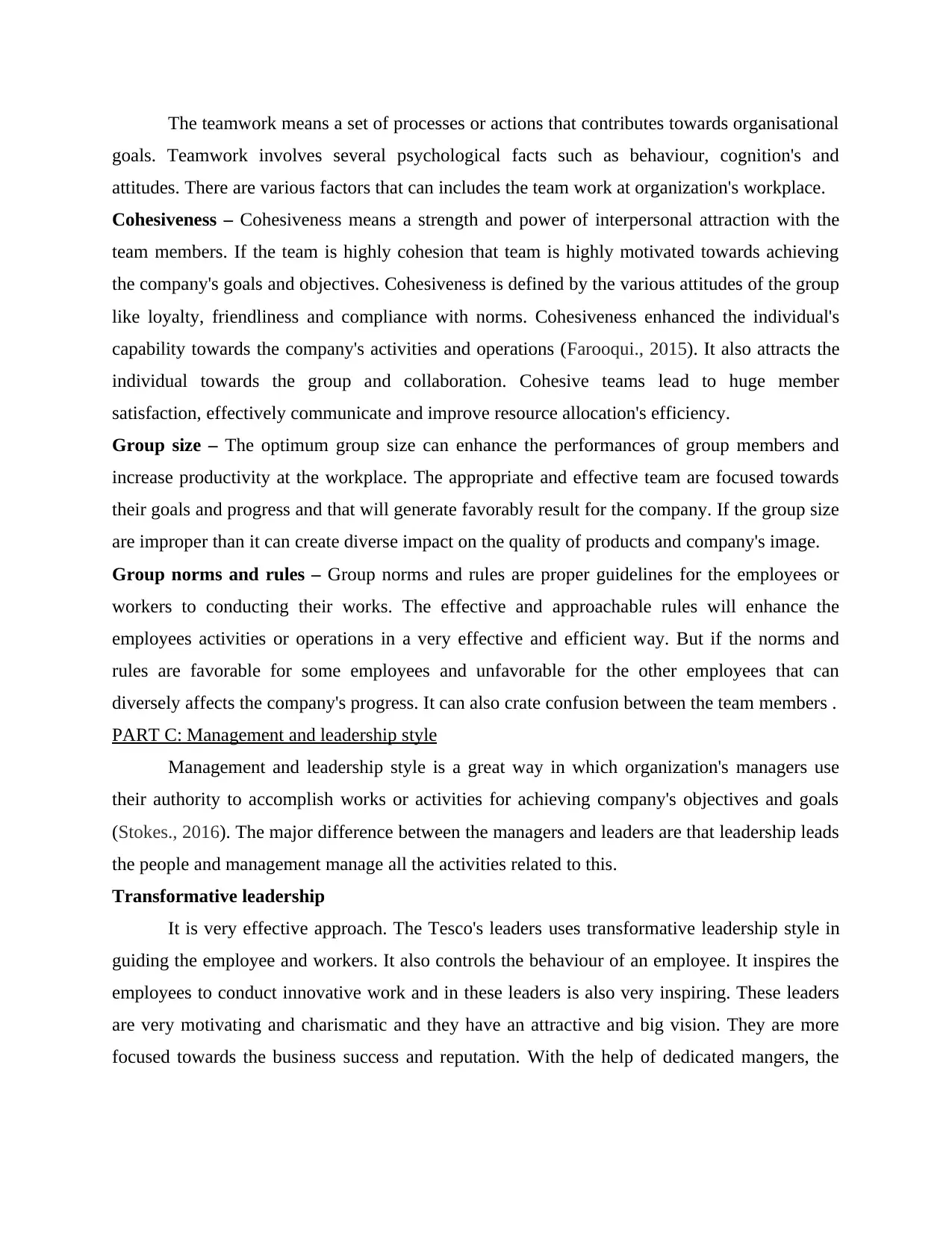
The teamwork means a set of processes or actions that contributes towards organisational
goals. Teamwork involves several psychological facts such as behaviour, cognition's and
attitudes. There are various factors that can includes the team work at organization's workplace.
Cohesiveness – Cohesiveness means a strength and power of interpersonal attraction with the
team members. If the team is highly cohesion that team is highly motivated towards achieving
the company's goals and objectives. Cohesiveness is defined by the various attitudes of the group
like loyalty, friendliness and compliance with norms. Cohesiveness enhanced the individual's
capability towards the company's activities and operations (Farooqui., 2015). It also attracts the
individual towards the group and collaboration. Cohesive teams lead to huge member
satisfaction, effectively communicate and improve resource allocation's efficiency.
Group size – The optimum group size can enhance the performances of group members and
increase productivity at the workplace. The appropriate and effective team are focused towards
their goals and progress and that will generate favorably result for the company. If the group size
are improper than it can create diverse impact on the quality of products and company's image.
Group norms and rules – Group norms and rules are proper guidelines for the employees or
workers to conducting their works. The effective and approachable rules will enhance the
employees activities or operations in a very effective and efficient way. But if the norms and
rules are favorable for some employees and unfavorable for the other employees that can
diversely affects the company's progress. It can also crate confusion between the team members .
PART C: Management and leadership style
Management and leadership style is a great way in which organization's managers use
their authority to accomplish works or activities for achieving company's objectives and goals
(Stokes., 2016). The major difference between the managers and leaders are that leadership leads
the people and management manage all the activities related to this.
Transformative leadership
It is very effective approach. The Tesco's leaders uses transformative leadership style in
guiding the employee and workers. It also controls the behaviour of an employee. It inspires the
employees to conduct innovative work and in these leaders is also very inspiring. These leaders
are very motivating and charismatic and they have an attractive and big vision. They are more
focused towards the business success and reputation. With the help of dedicated mangers, the
goals. Teamwork involves several psychological facts such as behaviour, cognition's and
attitudes. There are various factors that can includes the team work at organization's workplace.
Cohesiveness – Cohesiveness means a strength and power of interpersonal attraction with the
team members. If the team is highly cohesion that team is highly motivated towards achieving
the company's goals and objectives. Cohesiveness is defined by the various attitudes of the group
like loyalty, friendliness and compliance with norms. Cohesiveness enhanced the individual's
capability towards the company's activities and operations (Farooqui., 2015). It also attracts the
individual towards the group and collaboration. Cohesive teams lead to huge member
satisfaction, effectively communicate and improve resource allocation's efficiency.
Group size – The optimum group size can enhance the performances of group members and
increase productivity at the workplace. The appropriate and effective team are focused towards
their goals and progress and that will generate favorably result for the company. If the group size
are improper than it can create diverse impact on the quality of products and company's image.
Group norms and rules – Group norms and rules are proper guidelines for the employees or
workers to conducting their works. The effective and approachable rules will enhance the
employees activities or operations in a very effective and efficient way. But if the norms and
rules are favorable for some employees and unfavorable for the other employees that can
diversely affects the company's progress. It can also crate confusion between the team members .
PART C: Management and leadership style
Management and leadership style is a great way in which organization's managers use
their authority to accomplish works or activities for achieving company's objectives and goals
(Stokes., 2016). The major difference between the managers and leaders are that leadership leads
the people and management manage all the activities related to this.
Transformative leadership
It is very effective approach. The Tesco's leaders uses transformative leadership style in
guiding the employee and workers. It also controls the behaviour of an employee. It inspires the
employees to conduct innovative work and in these leaders is also very inspiring. These leaders
are very motivating and charismatic and they have an attractive and big vision. They are more
focused towards the business success and reputation. With the help of dedicated mangers, the
⊘ This is a preview!⊘
Do you want full access?
Subscribe today to unlock all pages.

Trusted by 1+ million students worldwide
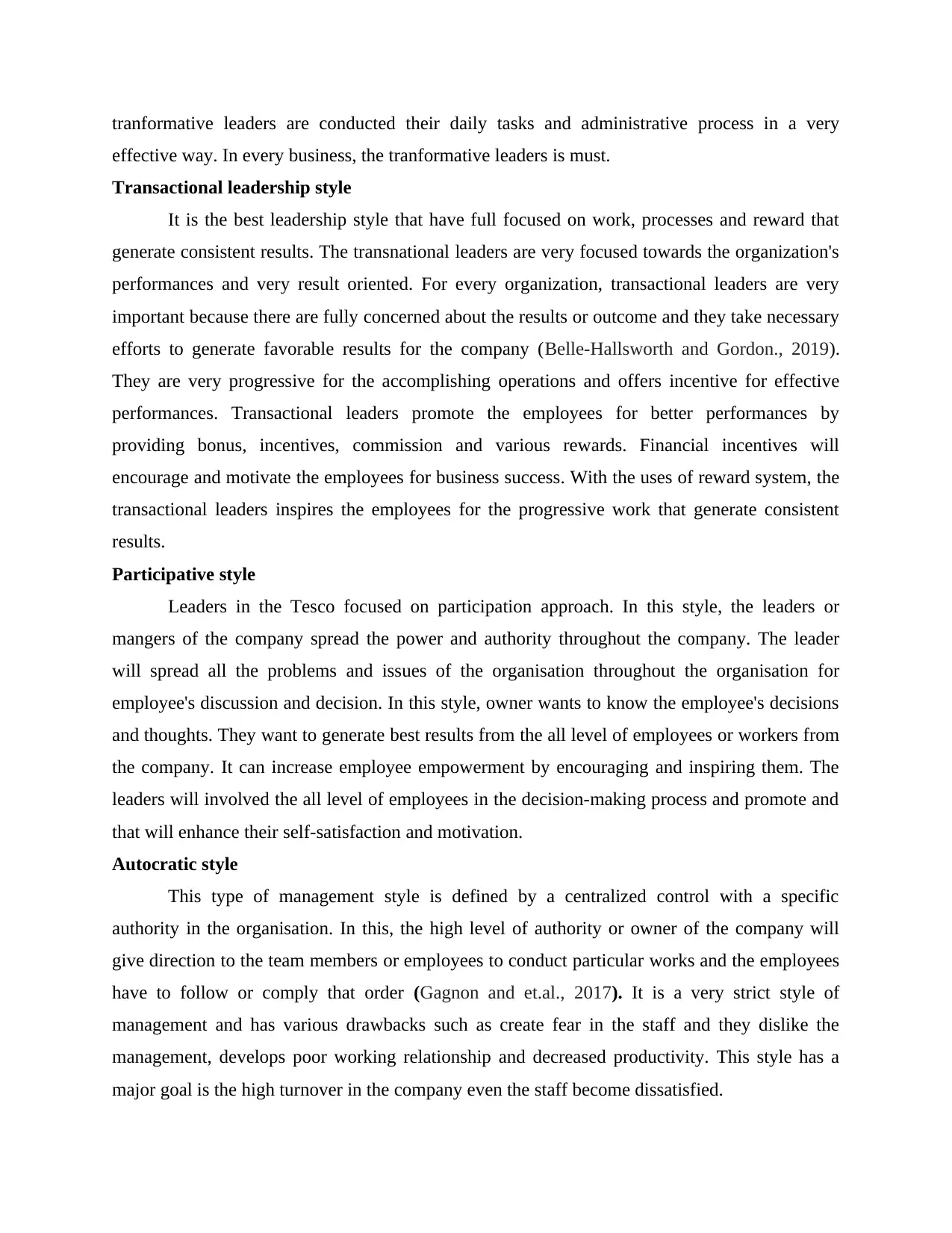
tranformative leaders are conducted their daily tasks and administrative process in a very
effective way. In every business, the tranformative leaders is must.
Transactional leadership style
It is the best leadership style that have full focused on work, processes and reward that
generate consistent results. The transnational leaders are very focused towards the organization's
performances and very result oriented. For every organization, transactional leaders are very
important because there are fully concerned about the results or outcome and they take necessary
efforts to generate favorable results for the company (Belle-Hallsworth and Gordon., 2019).
They are very progressive for the accomplishing operations and offers incentive for effective
performances. Transactional leaders promote the employees for better performances by
providing bonus, incentives, commission and various rewards. Financial incentives will
encourage and motivate the employees for business success. With the uses of reward system, the
transactional leaders inspires the employees for the progressive work that generate consistent
results.
Participative style
Leaders in the Tesco focused on participation approach. In this style, the leaders or
mangers of the company spread the power and authority throughout the company. The leader
will spread all the problems and issues of the organisation throughout the organisation for
employee's discussion and decision. In this style, owner wants to know the employee's decisions
and thoughts. They want to generate best results from the all level of employees or workers from
the company. It can increase employee empowerment by encouraging and inspiring them. The
leaders will involved the all level of employees in the decision-making process and promote and
that will enhance their self-satisfaction and motivation.
Autocratic style
This type of management style is defined by a centralized control with a specific
authority in the organisation. In this, the high level of authority or owner of the company will
give direction to the team members or employees to conduct particular works and the employees
have to follow or comply that order (Gagnon and et.al., 2017). It is a very strict style of
management and has various drawbacks such as create fear in the staff and they dislike the
management, develops poor working relationship and decreased productivity. This style has a
major goal is the high turnover in the company even the staff become dissatisfied.
effective way. In every business, the tranformative leaders is must.
Transactional leadership style
It is the best leadership style that have full focused on work, processes and reward that
generate consistent results. The transnational leaders are very focused towards the organization's
performances and very result oriented. For every organization, transactional leaders are very
important because there are fully concerned about the results or outcome and they take necessary
efforts to generate favorable results for the company (Belle-Hallsworth and Gordon., 2019).
They are very progressive for the accomplishing operations and offers incentive for effective
performances. Transactional leaders promote the employees for better performances by
providing bonus, incentives, commission and various rewards. Financial incentives will
encourage and motivate the employees for business success. With the uses of reward system, the
transactional leaders inspires the employees for the progressive work that generate consistent
results.
Participative style
Leaders in the Tesco focused on participation approach. In this style, the leaders or
mangers of the company spread the power and authority throughout the company. The leader
will spread all the problems and issues of the organisation throughout the organisation for
employee's discussion and decision. In this style, owner wants to know the employee's decisions
and thoughts. They want to generate best results from the all level of employees or workers from
the company. It can increase employee empowerment by encouraging and inspiring them. The
leaders will involved the all level of employees in the decision-making process and promote and
that will enhance their self-satisfaction and motivation.
Autocratic style
This type of management style is defined by a centralized control with a specific
authority in the organisation. In this, the high level of authority or owner of the company will
give direction to the team members or employees to conduct particular works and the employees
have to follow or comply that order (Gagnon and et.al., 2017). It is a very strict style of
management and has various drawbacks such as create fear in the staff and they dislike the
management, develops poor working relationship and decreased productivity. This style has a
major goal is the high turnover in the company even the staff become dissatisfied.
Paraphrase This Document
Need a fresh take? Get an instant paraphrase of this document with our AI Paraphraser
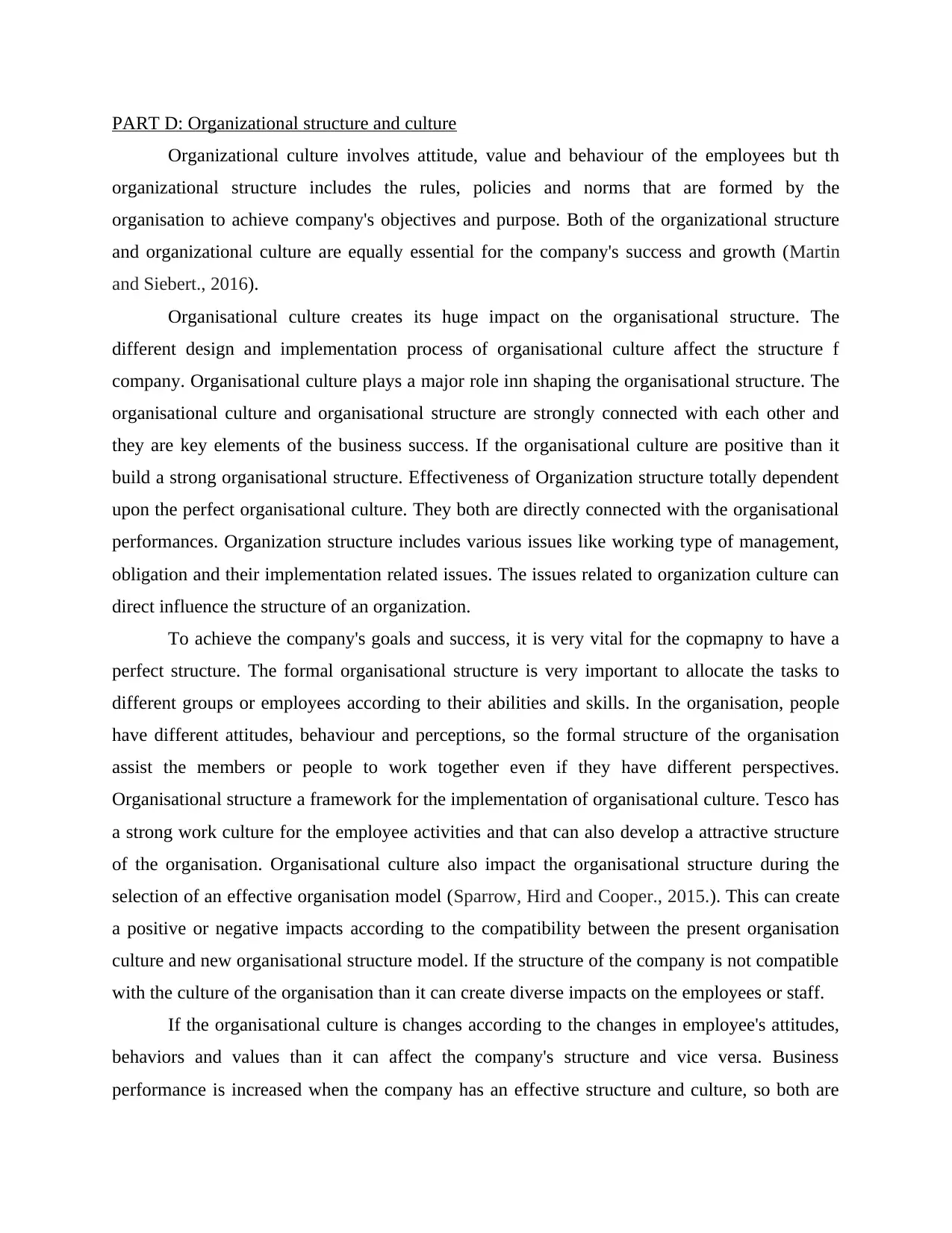
PART D: Organizational structure and culture
Organizational culture involves attitude, value and behaviour of the employees but th
organizational structure includes the rules, policies and norms that are formed by the
organisation to achieve company's objectives and purpose. Both of the organizational structure
and organizational culture are equally essential for the company's success and growth (Martin
and Siebert., 2016).
Organisational culture creates its huge impact on the organisational structure. The
different design and implementation process of organisational culture affect the structure f
company. Organisational culture plays a major role inn shaping the organisational structure. The
organisational culture and organisational structure are strongly connected with each other and
they are key elements of the business success. If the organisational culture are positive than it
build a strong organisational structure. Effectiveness of Organization structure totally dependent
upon the perfect organisational culture. They both are directly connected with the organisational
performances. Organization structure includes various issues like working type of management,
obligation and their implementation related issues. The issues related to organization culture can
direct influence the structure of an organization.
To achieve the company's goals and success, it is very vital for the copmapny to have a
perfect structure. The formal organisational structure is very important to allocate the tasks to
different groups or employees according to their abilities and skills. In the organisation, people
have different attitudes, behaviour and perceptions, so the formal structure of the organisation
assist the members or people to work together even if they have different perspectives.
Organisational structure a framework for the implementation of organisational culture. Tesco has
a strong work culture for the employee activities and that can also develop a attractive structure
of the organisation. Organisational culture also impact the organisational structure during the
selection of an effective organisation model (Sparrow, Hird and Cooper., 2015.). This can create
a positive or negative impacts according to the compatibility between the present organisation
culture and new organisational structure model. If the structure of the company is not compatible
with the culture of the organisation than it can create diverse impacts on the employees or staff.
If the organisational culture is changes according to the changes in employee's attitudes,
behaviors and values than it can affect the company's structure and vice versa. Business
performance is increased when the company has an effective structure and culture, so both are
Organizational culture involves attitude, value and behaviour of the employees but th
organizational structure includes the rules, policies and norms that are formed by the
organisation to achieve company's objectives and purpose. Both of the organizational structure
and organizational culture are equally essential for the company's success and growth (Martin
and Siebert., 2016).
Organisational culture creates its huge impact on the organisational structure. The
different design and implementation process of organisational culture affect the structure f
company. Organisational culture plays a major role inn shaping the organisational structure. The
organisational culture and organisational structure are strongly connected with each other and
they are key elements of the business success. If the organisational culture are positive than it
build a strong organisational structure. Effectiveness of Organization structure totally dependent
upon the perfect organisational culture. They both are directly connected with the organisational
performances. Organization structure includes various issues like working type of management,
obligation and their implementation related issues. The issues related to organization culture can
direct influence the structure of an organization.
To achieve the company's goals and success, it is very vital for the copmapny to have a
perfect structure. The formal organisational structure is very important to allocate the tasks to
different groups or employees according to their abilities and skills. In the organisation, people
have different attitudes, behaviour and perceptions, so the formal structure of the organisation
assist the members or people to work together even if they have different perspectives.
Organisational structure a framework for the implementation of organisational culture. Tesco has
a strong work culture for the employee activities and that can also develop a attractive structure
of the organisation. Organisational culture also impact the organisational structure during the
selection of an effective organisation model (Sparrow, Hird and Cooper., 2015.). This can create
a positive or negative impacts according to the compatibility between the present organisation
culture and new organisational structure model. If the structure of the company is not compatible
with the culture of the organisation than it can create diverse impacts on the employees or staff.
If the organisational culture is changes according to the changes in employee's attitudes,
behaviors and values than it can affect the company's structure and vice versa. Business
performance is increased when the company has an effective structure and culture, so both are
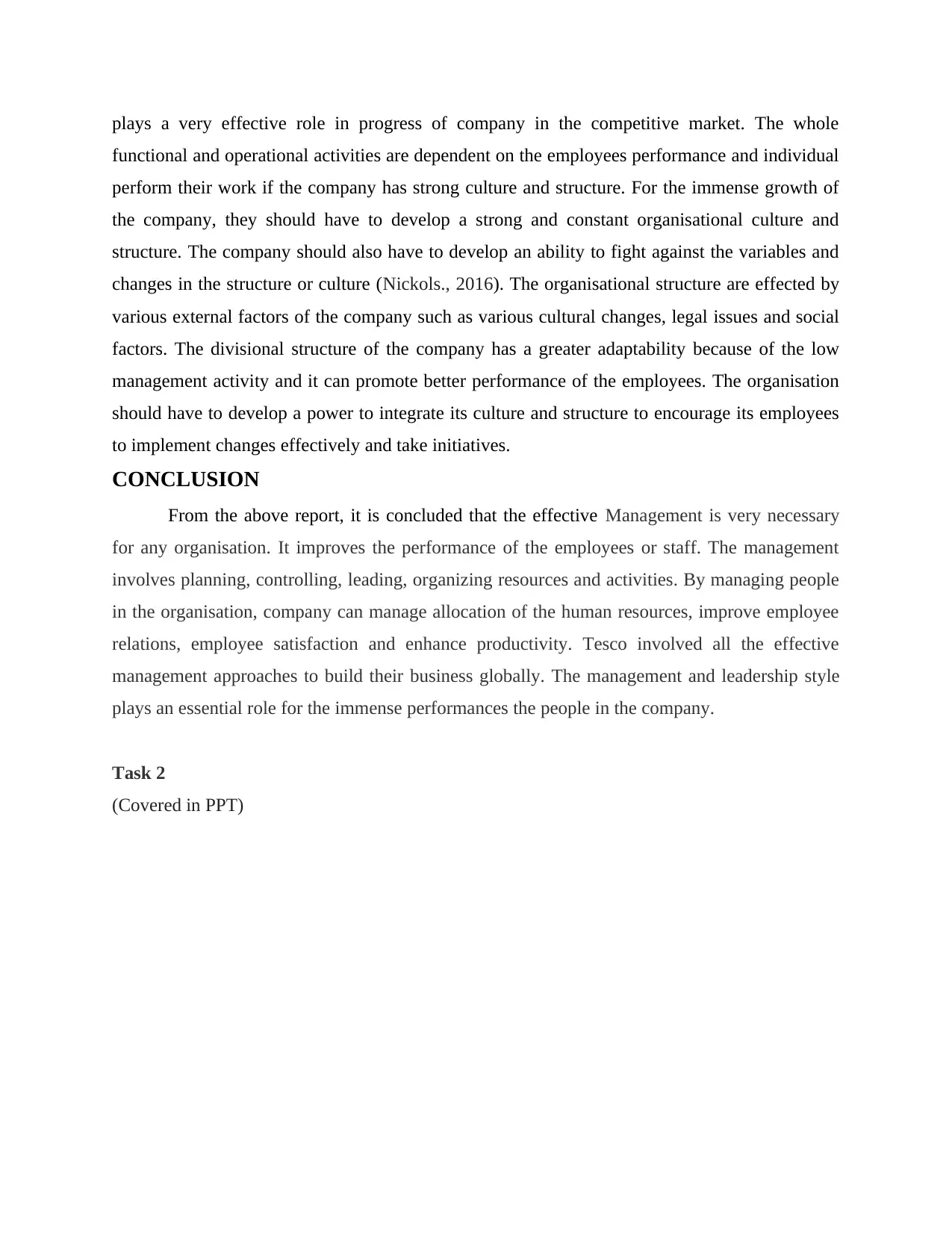
plays a very effective role in progress of company in the competitive market. The whole
functional and operational activities are dependent on the employees performance and individual
perform their work if the company has strong culture and structure. For the immense growth of
the company, they should have to develop a strong and constant organisational culture and
structure. The company should also have to develop an ability to fight against the variables and
changes in the structure or culture (Nickols., 2016). The organisational structure are effected by
various external factors of the company such as various cultural changes, legal issues and social
factors. The divisional structure of the company has a greater adaptability because of the low
management activity and it can promote better performance of the employees. The organisation
should have to develop a power to integrate its culture and structure to encourage its employees
to implement changes effectively and take initiatives.
CONCLUSION
From the above report, it is concluded that the effective Management is very necessary
for any organisation. It improves the performance of the employees or staff. The management
involves planning, controlling, leading, organizing resources and activities. By managing people
in the organisation, company can manage allocation of the human resources, improve employee
relations, employee satisfaction and enhance productivity. Tesco involved all the effective
management approaches to build their business globally. The management and leadership style
plays an essential role for the immense performances the people in the company.
Task 2
(Covered in PPT)
functional and operational activities are dependent on the employees performance and individual
perform their work if the company has strong culture and structure. For the immense growth of
the company, they should have to develop a strong and constant organisational culture and
structure. The company should also have to develop an ability to fight against the variables and
changes in the structure or culture (Nickols., 2016). The organisational structure are effected by
various external factors of the company such as various cultural changes, legal issues and social
factors. The divisional structure of the company has a greater adaptability because of the low
management activity and it can promote better performance of the employees. The organisation
should have to develop a power to integrate its culture and structure to encourage its employees
to implement changes effectively and take initiatives.
CONCLUSION
From the above report, it is concluded that the effective Management is very necessary
for any organisation. It improves the performance of the employees or staff. The management
involves planning, controlling, leading, organizing resources and activities. By managing people
in the organisation, company can manage allocation of the human resources, improve employee
relations, employee satisfaction and enhance productivity. Tesco involved all the effective
management approaches to build their business globally. The management and leadership style
plays an essential role for the immense performances the people in the company.
Task 2
(Covered in PPT)
⊘ This is a preview!⊘
Do you want full access?
Subscribe today to unlock all pages.

Trusted by 1+ million students worldwide
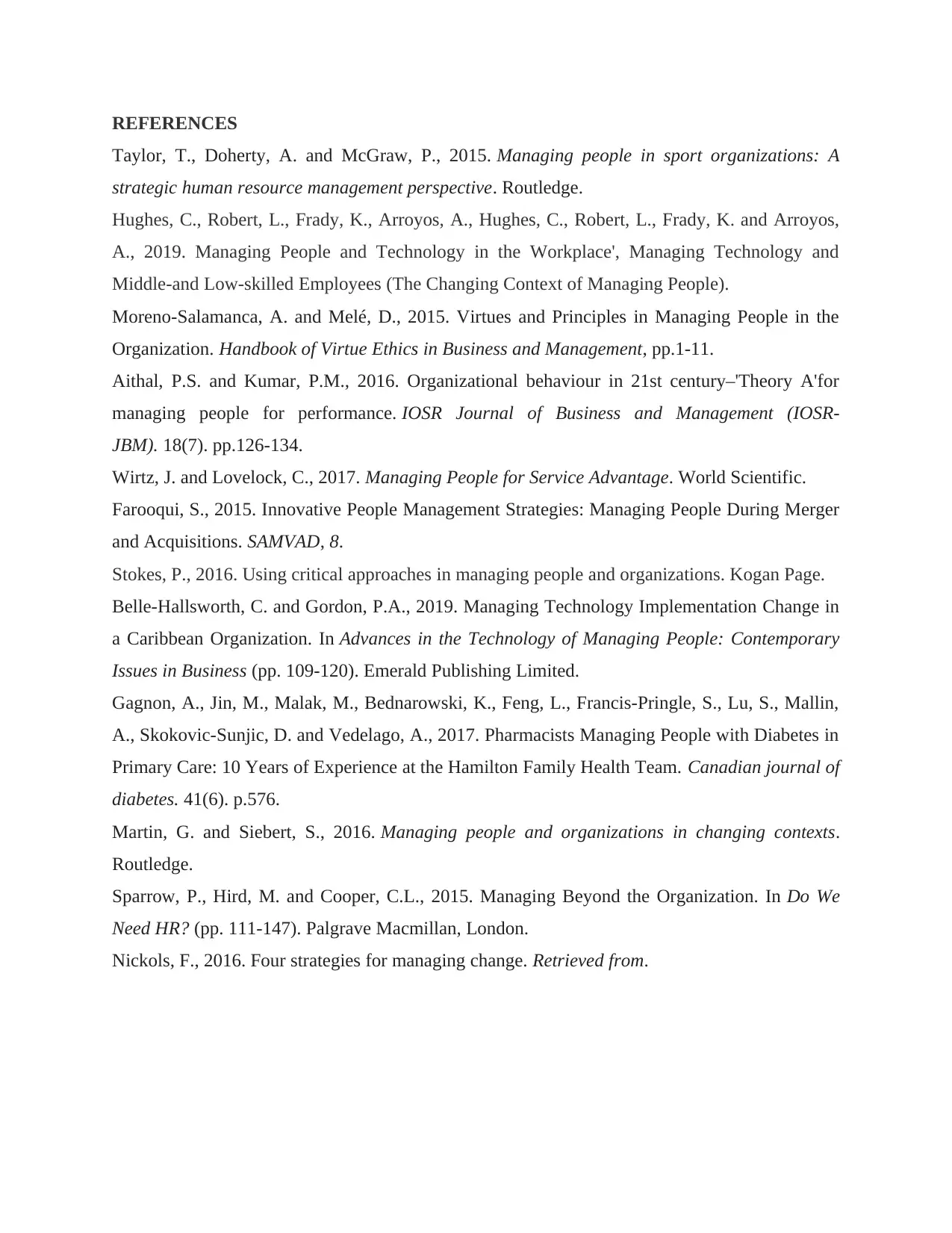
REFERENCES
Taylor, T., Doherty, A. and McGraw, P., 2015. Managing people in sport organizations: A
strategic human resource management perspective. Routledge.
Hughes, C., Robert, L., Frady, K., Arroyos, A., Hughes, C., Robert, L., Frady, K. and Arroyos,
A., 2019. Managing People and Technology in the Workplace', Managing Technology and
Middle-and Low-skilled Employees (The Changing Context of Managing People).
Moreno-Salamanca, A. and Melé, D., 2015. Virtues and Principles in Managing People in the
Organization. Handbook of Virtue Ethics in Business and Management, pp.1-11.
Aithal, P.S. and Kumar, P.M., 2016. Organizational behaviour in 21st century–'Theory A'for
managing people for performance. IOSR Journal of Business and Management (IOSR-
JBM). 18(7). pp.126-134.
Wirtz, J. and Lovelock, C., 2017. Managing People for Service Advantage. World Scientific.
Farooqui, S., 2015. Innovative People Management Strategies: Managing People During Merger
and Acquisitions. SAMVAD, 8.
Stokes, P., 2016. Using critical approaches in managing people and organizations. Kogan Page.
Belle-Hallsworth, C. and Gordon, P.A., 2019. Managing Technology Implementation Change in
a Caribbean Organization. In Advances in the Technology of Managing People: Contemporary
Issues in Business (pp. 109-120). Emerald Publishing Limited.
Gagnon, A., Jin, M., Malak, M., Bednarowski, K., Feng, L., Francis-Pringle, S., Lu, S., Mallin,
A., Skokovic-Sunjic, D. and Vedelago, A., 2017. Pharmacists Managing People with Diabetes in
Primary Care: 10 Years of Experience at the Hamilton Family Health Team. Canadian journal of
diabetes. 41(6). p.576.
Martin, G. and Siebert, S., 2016. Managing people and organizations in changing contexts.
Routledge.
Sparrow, P., Hird, M. and Cooper, C.L., 2015. Managing Beyond the Organization. In Do We
Need HR? (pp. 111-147). Palgrave Macmillan, London.
Nickols, F., 2016. Four strategies for managing change. Retrieved from.
Taylor, T., Doherty, A. and McGraw, P., 2015. Managing people in sport organizations: A
strategic human resource management perspective. Routledge.
Hughes, C., Robert, L., Frady, K., Arroyos, A., Hughes, C., Robert, L., Frady, K. and Arroyos,
A., 2019. Managing People and Technology in the Workplace', Managing Technology and
Middle-and Low-skilled Employees (The Changing Context of Managing People).
Moreno-Salamanca, A. and Melé, D., 2015. Virtues and Principles in Managing People in the
Organization. Handbook of Virtue Ethics in Business and Management, pp.1-11.
Aithal, P.S. and Kumar, P.M., 2016. Organizational behaviour in 21st century–'Theory A'for
managing people for performance. IOSR Journal of Business and Management (IOSR-
JBM). 18(7). pp.126-134.
Wirtz, J. and Lovelock, C., 2017. Managing People for Service Advantage. World Scientific.
Farooqui, S., 2015. Innovative People Management Strategies: Managing People During Merger
and Acquisitions. SAMVAD, 8.
Stokes, P., 2016. Using critical approaches in managing people and organizations. Kogan Page.
Belle-Hallsworth, C. and Gordon, P.A., 2019. Managing Technology Implementation Change in
a Caribbean Organization. In Advances in the Technology of Managing People: Contemporary
Issues in Business (pp. 109-120). Emerald Publishing Limited.
Gagnon, A., Jin, M., Malak, M., Bednarowski, K., Feng, L., Francis-Pringle, S., Lu, S., Mallin,
A., Skokovic-Sunjic, D. and Vedelago, A., 2017. Pharmacists Managing People with Diabetes in
Primary Care: 10 Years of Experience at the Hamilton Family Health Team. Canadian journal of
diabetes. 41(6). p.576.
Martin, G. and Siebert, S., 2016. Managing people and organizations in changing contexts.
Routledge.
Sparrow, P., Hird, M. and Cooper, C.L., 2015. Managing Beyond the Organization. In Do We
Need HR? (pp. 111-147). Palgrave Macmillan, London.
Nickols, F., 2016. Four strategies for managing change. Retrieved from.
1 out of 10
Related Documents
Your All-in-One AI-Powered Toolkit for Academic Success.
+13062052269
info@desklib.com
Available 24*7 on WhatsApp / Email
![[object Object]](/_next/static/media/star-bottom.7253800d.svg)
Unlock your academic potential
Copyright © 2020–2025 A2Z Services. All Rights Reserved. Developed and managed by ZUCOL.



